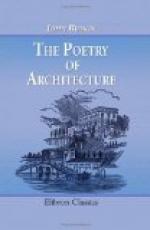[Footnote 42: Every one who is about to lay out a limited extent of garden, in which he wishes to introduce many flowers, should read and attentively study, first Shelley, and next Shakspeare. The latter indeed induces the most beautiful connections between thought and flower that can be found in the whole range of European literature; but he very often uses the symbolical effect of the flower, which it can only have on the educated mind, instead of the natural and true effect of the flower, which it must have, more or less, upon every mind. Thus, when Ophelia, presenting her wild flowers, says, “There’s rosemary, that’s for remembrance; pray you, love, remember: and there is pansies, that’s for thoughts:” the infinite “beauty of the passage depends entirely upon the arbitrary meaning attached to the flowers. But, when Shelley speaks of
“The
lily of the vale,
Whom youth makes so fair,
and passion so pale,
That the light of her tremulous
bells is seen
Through their pavilion of
tender green,”
he is etherealizing an impression which the mind naturally receives from the flower. Consequently, as it is only by their natural influence that flowers can address the mind through the eye, we must read Shelley, to learn how to use flowers, and Shakspeare, to learn to love them. In both writers we find the wild flower possessing soul as well as life, and mingling its influence most intimately, like an untaught melody, with the deepest and most secret streams of human emotion.]
212. Perhaps we should apologize for introducing this in the Architectural Magazine; but it is not out of place: the garden is almost a necessary adjunct of the Elizabethan villa, and all garden architecture is utterly useless unless it be assisted by the botanical effect.
These, then, are a few of the more important principles of architecture, which are to be kept in view in the blue and in the green country. The wild, or gray, country is never selected, in Britain, as the site of a villa; and, therefore, it only remains for us to offer a few remarks on a subject as difficult as it is interesting and important, the architecture of the villa in British hill, or brown, country.
VII.
THE BRITISH VILLA.—PRINCIPLES OF COMPOSITION.
D. Hill, or Brown Country.
“Vivite contenti casulis et collibus istis.”—Juvenal [xiv. 179.]
213. In the Boulevard des Italiens, just at the turning into the Rue de la Paix (in Paris), there stand a few dusky and withered trees, beside a kind of dry ditch, paved at the bottom, into which a carriage can with some difficulty descend, and which affords access (not in an unusual manner) to the ground floor of a large and dreary-looking house, whose passages are dark and confined, whose rooms are limited in size, and whose windows command an interesting view of the dusky trees before mentioned.




